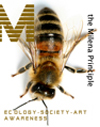
the Milena principle: introduction >
• INTRODUCTION • CONCEPTS • MADE OF WALKING • FILM ARCHIVE & VIDEO •
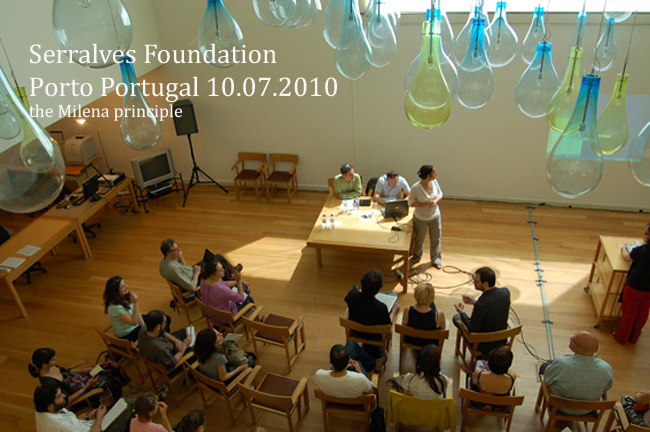
the Milena principle is a 'think tank' with a global vision in which people from several European countries come together. The group is made up of artists and experts from various domains and disciplines including science, ecology, alternative health therapies, literature, art history, sound art and music, architecture, technology and philosophy. Acting as an independent art platform we distinguishing ourselves by working on unconventional ways and by establishing unexpected and nomadic debates on art [source: curator Artemis Potamianou > MOMA NY & Tate London UK > Art Athina 2014].
![]()
[ Human Capital ]
We work as an nomadic European organisation and we realized art events in countries all over Europe. Within the projects of the Milena principle various international artists, writers, scientists come together and cooperate, create with a multi- and interdisciplinary attitude and reflect about the border crossing aspects of culture, art, science, ecology and health. One of the important aspects of the Milena principle members is their individual research in various fields such as art, philosophy and science. the Milena principle wants to invest in Human Capital.
the Milena principle organized a variety of artistic and cultural events connecting people throughout Europe in the last decade. We built a network of international partners in more then 15 countries, including private persons, cultural institutions, universities and museums, all established through personal contacts. The majority of activities were realized on basis of voluntary work of our team and international partners, with no or little money nor governmental help.

![]()
[ A Nomadic Museum ]
Our events are processes, laboratories of a feeling thinking in which instruments of art are as well instruments of science and knowledge. It are human fields, artistic pop up events, meeting places in an intimate atmosphere open to participation of the public and community. A humanist attitudes merges as well with an artistic one. We refer the nomadic aspect of renaissance artists, who did not only travel with their work through Europe but also made connections with all the places they visited.
Renaissance artists, scientists and philosophers found each other via their common interest for a new philosophy. Through exchanges of ideas with artist and friends, whom they visited during their continuious journeys, they created a network of solidarity and affinity. Our art projects have an explicit utopian and human dimension. We believe that we are not individuals in our own right, but who become human in relation to others.

[ The Dürer Connection ]
Albrecht Dürer [1471-1528] visited the Netherlands and Flanders [Antwerp in 1520]: the Milena principle wants to actualize this old tradition. These great renaissance persons found each other via their common interest and thinking. Through their travels they moved boundaries, they travelled with and via ideas. Through exchanges of ideas with artist friends, whom they visited during these long journeys, they created a network of solidarity and affinity.
All events are linked with 'the Dürer connection', a guideline within the projects of the Milena principle, referring to the nomadic aspect of renaissance artists, travelling with their work through Europe and making connections with the places they visited and with the people they met. Renaissance artists, scientists and philosophers exchanged ideas on a border crossing way and in an atmosphere of friendship, during mutual visits on their continuous journeys. Our art projects connect explicitly with this European, utopian and human dimension.
the Milena principle focuses on the ongoing travelling project "the Dürer connection" (2003 - ), developing itself as an European nomadic network, initiating collaborative encounters between public, experts and artists, referring to the Flemish renaissance, when artists, philosophers and scientists traveled unceasingly, connecting with people and places. The projects refer to this utopian and human dimension, with traveling as an artistic instrument, with events and exhibitions realized in Germany, Holland, Portugal, Poland, Spain, Italy, Czech Republic, Romania, Austria, Serbia, Slovenia, Bosnia and Herzegovina, Albania, Kosovo, Macedonia, Greece, Crete, parallel events in Latin America, as well bringing artists and people from many European countries to Belgium.
![]()
[ Mapping our working space ]
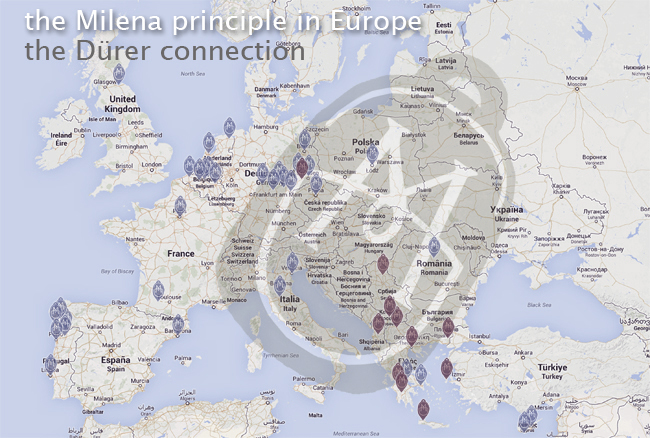
Amsterdam - Antwerp - Athens -Barcelona - Belgrado - Berlin - Beveren - Braga - Brasilia - Bruges - Chania - Chemnitz - Chios - Compostella - Delphi - Dimitsana - Dresden - Edinburgh - Essen - Florence - Ghent - Guimaraes - Jahnishausen - Kassel - La Romieu - Leipzig - Limassol - Lisbon - Lodz - Ljubljana - Naumburg - Neo Chorio - New York - Nicosia - Nieuwolda - Paris - Patras - Porto - Prague - Prishtina - Santiago de Compostela - Sint-Niklaas - Skopje - Soufi - Thessaloniki - Tinos - Tirana - Tirgu Mures - Tongeren - Venice - Vigo - Weimar
![]()
[ An independent art platform ]
Curator Artemis Potamianou (MOMA & Tate London), who is currently based in Athens, considers the Milena principle as one of the 49 most important independent art platforms from all over the world, distinguishing themselves by working on unconventional ways and by establishing unexpected and influential debates on art. Based on the “unity is strength” principle, the platforms have secured their own place on the international art arena without antagonizing the environment they are called upon to serve.
[the Milena principle was selected by Artemis Potamianou for the Athens Art Fair, ART-ATHINA 2014. Platforms project].
The vision of the body as an instrument of art and knowledge and guidelines as serenity, silence, intimacy, enchantment, inspiration are defining our way of working. What could an ecological art of living look like? How can we get there – how do we have to change our behaviour, what can we contribute as individuals? What new interpretations and concepts do we need? The French author [winner of the Nobel Prize in Literature in 1947], André Gide said: 'I have no use for knowledge that has not been preceded by a sensation'.

![]()
[ The Politics of the Heart ] a multidisciplinary field of community
One of the aims of the Milena principle is to create a forum for cross-border working around the essence of politics as a poetic, creative, human instrument. 'Nomads of a new era', moving in a field of art, ecology, philosophy and politics, fed by utopian ideas. Terms as "solidarity" or "togetherness" are considered as an inexhaustible source of inspiration. The aim is to organize seminars with participants from different tendencies in a common project.
New alliances need to be formed among all actors in society at both national and international level for us to overcome the challenges posed by the climate and resource crisis. Innovative alliances between various actors will be presented at this event. The focus will also be how to mobilise people to enter into new alliances. Collaboration among different groups with their specific (work) cultures brings with it a host of difficulties.
The discussion will also revolve around strategies for overcoming these difficulties. Which new skills do we need in the environmental crisis to be able to lead the good life? Can the promise of the industrial age – that economic growth can "create" prosperity and thus happiness for the individual – still play a role? The equation prosperity = happiness is no longer true. Can a new art of living help us achieve what we call happiness?

![]()
[ Growing silence ] silence as an instrument of experience
A project to promote the qualities of silence and space in an urban context. Our project is about the experience and importance of urban silence and the connection between space and silence. Not the physical definition of silence, or the acoustical definition counts. Through a phenomenological approach to silence the artists explore how sound unambiguously works on the human being (in this case in an urban context). Silence is an instrument of experience and as well as an instrument of knowledge.
The project wants to realize a cultural bridge between the presence of silence as access to historical and natural soundscapes and the inner experience of silence. Silence is not limited to a material-acoustical aspect, silence is as well a part of city life as an inner space, a breathing space.
This project tries to involve young people in the making of and creating of (urban) silence. We invite students and young artists into the design process and try to engage them in the future development of their environment and to excite them about the city. Approaching silence will explore silence in the city, looking for design tools for the shaping of places and urban experiences.
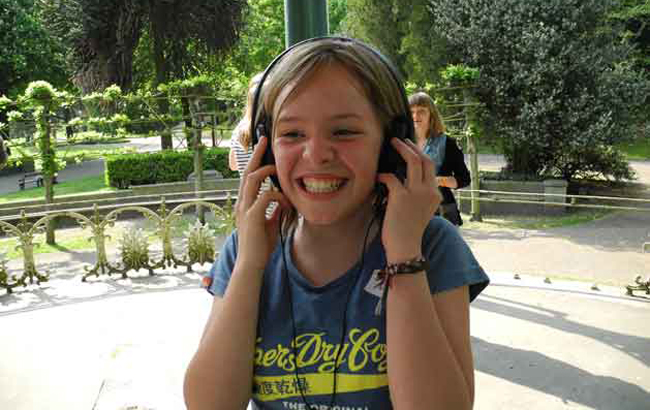
![]()
[ Amplified Gestures ]
Often acoustic space is ignored in the construction of a public space. The prevalence of noise or sounds that do not convey any social significance and are a disturbance of the quality of life, reduces the ability to identify with the place we inhabit.
It is therefore urgent to think about the acoustical problems societies are facing today and integrate that thinking in urban planning, architecture and management of public space, because the idea we have of ourselves, our personal awareness and the relationships we build in the external world, are inextricably linked to a space. We all exist somewhere. And personal identity also relates to this.

![]()
Image of the Leafless (IV) performance by Lina Efstathiou 20.05.2018.
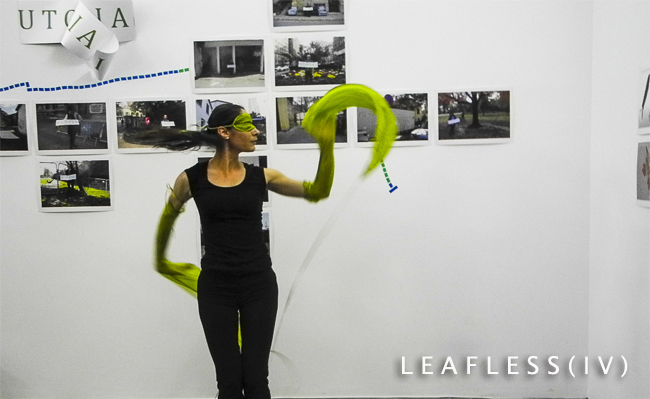
Utopia Book [version IV] Platform Projects [Independent Art Fair] Athens 2018.
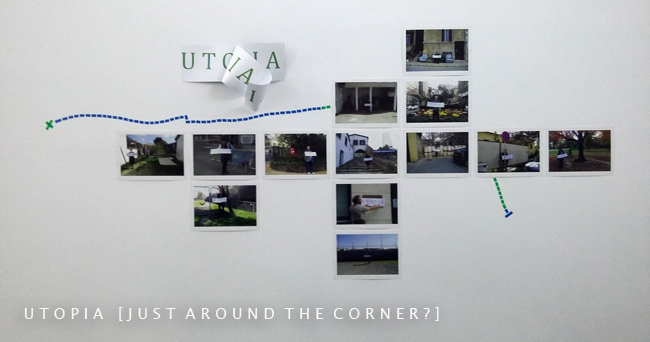
Presentation of the Utopia Book at Platform Projects [the Independed Art Fair] School of Fine Arts Athens 2018. Booth 29 the Milena principle. Curated by Artemis Potamianou (Moma NY & Tate London)
'Utopia (just around the corner). A silent group walk, moving in a flow through Nicosia, Brussels, NY City, with no other intention then to get lost, with a book, inspired by Thomas More's, but containing only one word, "Utopia". It is a book that resembles a walk, it is not linear, it opens from different angles, it has pages folded in pages, you can open and browse it in different directions, not a book to be read, but a book to be shared spontaneously between the participating walkers, to be carried around in silence and to be opened on places that come towards them, as an inviting to open and read the place, the walkers and the moment in which they stand.

Curator Artemis Potamianou (MOMA NY & Tate London), who is currently based in Athens, considers the Milena principle as one of the 49 most important independent art platforms from all over the world, distinguishing themselves by working on unconventional ways and by establishing unexpected and influential debates on art. Based on the “unity is strength” principle, the platforms have secured their own place on the international art arena without antagonizing the environment they are called upon to serve.
Curator Artemis Potamianou and the selection committee of Platforms project 2018 selected the Milena principle as one of the 40 representative art platforms worldwide to showcase their work and collaborations in Lisbon and Athens.
the Milena principle presents together with befriended collectives and organisations in Lisbon and Athens a collaborative sound-and visual installation, demonstrating the effect towards other cities, through a network of artistic interventions with remote users from other cities. The juxtaposition of artistic interventions and experiences of different urban environments suggesting the acknowledgement of coherence emphasized in the practices of everyday life-urban rituals, rather than the contrast implied by the geographical and cultural differences.

the Milena principle at ART-ATHINA Patforms Project Athens Greece 26>29 May 2016.
Art-Athina 2014-2015-2016. Faliro Pavilion (TaeKwonDo Stadium) Athens.
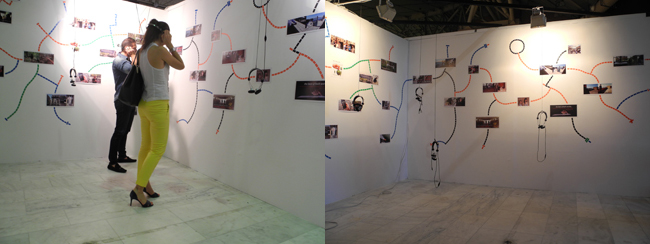
the Milena principle at Art Athina 2014, 2015 & 2016:
Our Nomadic Museum 2000-2016
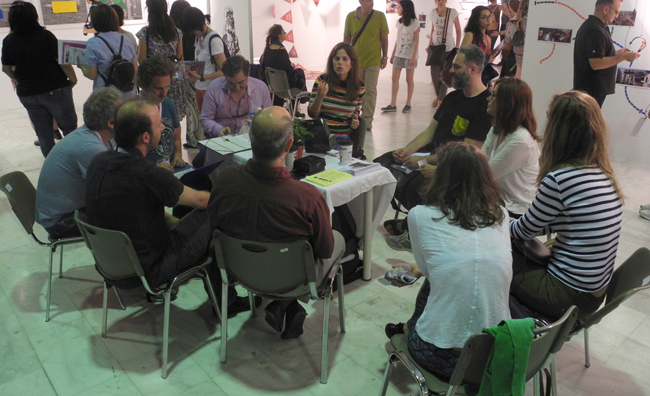
The Milena principle Stand Art Athina 2016.The Milena principle Stand Art Athina 2016.
Public Talk about sound art by Andromachi Vrakatseli B in our stand at Art Athina 2016. With Georgos Samantas, Nicos Bubaris, Andromachi Vrakatseli B, Ioannis Vandoulakis, Geert Vermeire & Sinan Bökesoy.
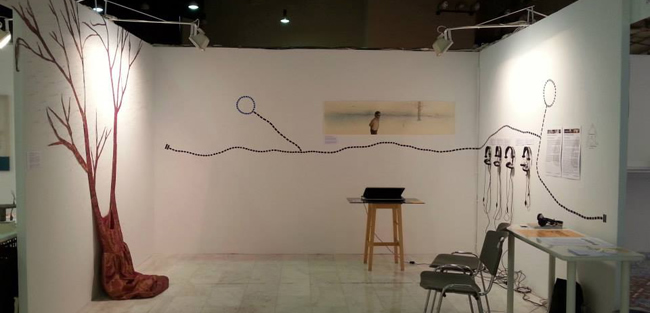
Platforms project. 49 of the most important independent art platforms from all over the world, distinguishing themselves by working on unconventional ways and by establishing unexpected and influential debates on art, were selected by the Athens Art Fair. Based on the “unity is strength” principle, the platforms have secured their own place on the international art arena without antagonizing the environment they are called upon to serve.
the Milena principle focuses on the ongoing travelling project "the Dürer connection" [2003 -], developing itself as an European nomadic network , initiating collaborative encounters between public, experts and artists, referring to the Flemish renaissance, when artists, philosophers and scientists traveled unceasingly, connecting with people and places.
Exchange of ideas and continuous journeys created a network of solidarity and affinity. The projects refer to this utopian and human dimension, with traveling as an artistic instrument, with events and exhibitions realized in Germany, Holland, Portugal, Poland, Spain, Italy, Czech Republic, Romania, Austria, Serbia, Slovenia, Bosnia and Herzegovina, Albania, Kosovo, Macedonia, Greece, Crete, parallel events in Latin America, as well bringing artists and people from many European countries to Belgium.
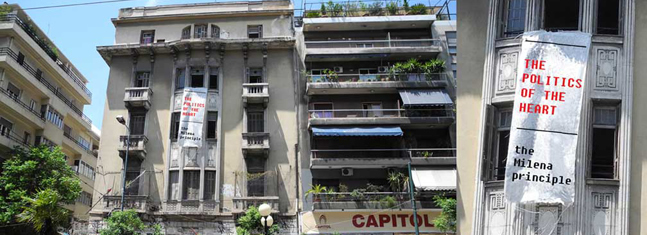
![]()

The Path of Dürer:
the Milena principle focuses on the ongoing travelling project "the Dürer connection" (2003 - ), developing itself as an European nomadic network , initiating collaborative encounters between public, experts and artists, referring to the Flemish renaissance, when artists, philosophers and scientists traveled unceasingly, connecting with people and places. Exchange of ideas and continuous journeys created a network of solidarity and affinity.
The projects refer to this utopian and human dimension, with traveling as an artistic instrument, with events and exhibitions realized in Germany, Holland, Portugal, Poland, Spain, Italy, Czech Republic, Romania, Austria, Serbia, Slovenia, Bosnia and Herzegovina, Albania, Kosovo, Macedonia, Greece, Crete, parallel events in Latin America, as well bringing artists and people from many European countries to Belgium.

The 'Path of Dürer' is an artistic trajectory, to create collaborative and participative art works on places that needs attention and care, considering the city as a living being made out of its inhabitants. Traveling is a laboratory for exchange with movement through the city as catalyst for urban change, with minimal interventions. As 'artists-nomads’ moving in a field of art, ecology, and politics, fed by utopic ideas and concepts we want organize international exchange in an European trajectory of various participative street actions with the Table as departing point.
Our focus will be how to mobilize people into new alliances starting from the idea “What if art would be the platform to give shape to society, working with a politics as a poetic, creative and human instrument”. Collaboration among different groups with their specific cultures brings with its complexities. Our topics also revolves around strategies for overcoming these complexities.
Concepts as "solidarity", "connection" and "togetherness" are a source of artistic inspiration within our group of artists - experts from various domains and disciplines including science, alternative health therapies, literature, art history, sound art and music, architecture, technology and philosophy.
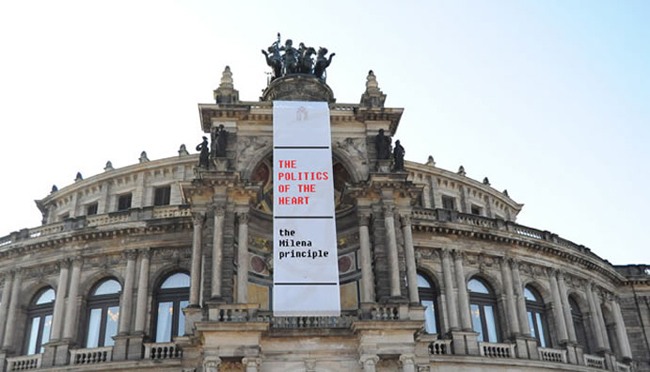
![]()
• INTRODUCTION • CONCEPTS • MADE OF WALKING • FILM ARCHIVE & VIDEO •
